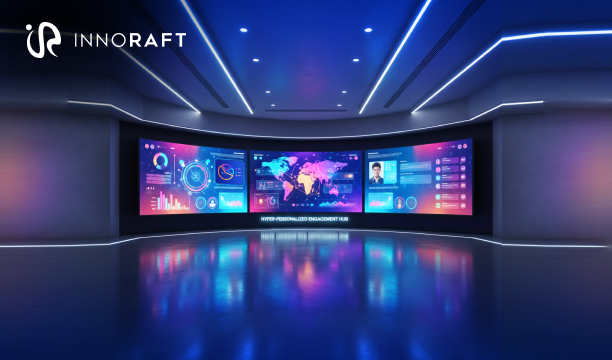Ever wondered why brands you've known for years suddenly feel more connected to you? Why do some businesses seem to anticipate your needs before you even articulate them?
It's no accident. It is the result of a strategic shift - one that places customer experience at the very core of enterprise growth. And at the heart of that strategy lies a powerful tool: the Customer Experience Center.
In a world where attention spans are short, loyalty is volatile, and digital noise is louder than ever, your ability to deliver a memorable, human-centered experience can make or break your enterprise. Attracting users is no longer enough. Converting them is only half the game. Retaining them and turning them into advocates demands a lot more.
That's where Customer Experience Center strategy come in.
The Challenge: Engagement in The Age of Expectation
It is no longer about competing with your industry competitors. You're up against every single great experience your customer has ever had, whether that's from a tech giant, a startup, or even a hyper-personalized eCommerce store.
Modern users expect:
- Seamless omnichannel interactions spanning multiple devices, browsers, and apps.
- Hyper-personalized services in the form of uniquely customized products, offers,
services, and messaging - Emotionally resonant branding that feels relevant and engaging.
- Quick resolution and proactive support that can solve customer issues fast.
Delivering on these requirements needs more than just a software or CRM platform. You need centralized, B2B customer engagement solutions that can tie together your customer strategy, design thinking, technology innovation, and brand storytelling.
Enter The Customer Experience Center
Customer experience centers are dedicated, immersive spaces strategically designed as Digital experience centers for enterprises to provide customers with a hands-on experience of your products/services. They are designed to:
- Showcase your innovations in real-time.
- Foster co-creation with clients and partners as customer co-creation spaces
- Demonstrate brand purpose through interaction, not just messaging.
- Bridge the gap between digital and human touchpoints.
CECs are not just shiny new assets; they are spaces where you can tell your business story in a detailed, engaging way.
Why are Enterprises Investing In CEC?
Understandably, CECs are really powerful in terms of building a great customer relationship. But is that the only benefits of customer experience centers?
Customer experience centers are not just a trend but a foundational element to modern CX strategies. Here's why businesses are investing heavily in them:
Turning Brand Promises Into Tangible Experiences
You can say that your product is innovative or that your brand is customer-obsessed. But saying it isn't enough anymore. With a Digital experience center for enterprises, customers can see, touch, and interact with your solutions firsthand. Investing in a customer experience center helps your customers to experience your value proposition, making them not only informed but also transformed.
Accelerating B2B Relationships Through Co-Creation
In B2B contexts, especially, sales cycles are longer and trust is everything. CEC works as a perfect B2B customer engagement solutions and allows you to invite key accounts, stakeholders, or even prospects into a collaborative environment, where workshops, ideation sessions, and roadmap planning feel less transactional and more like a true partnership. This fosters:
- Faster alignment on goals
- Customized solution design
- Stronger emotional buy-in
The result? Accelerated decision making and longer-lasting client relationships.
Empowering Cross-Functional Collaboration
Modern enterprises are often siloed - product, marketing, sales, and support often operate in parallel rather than in unison. Customer experience center act as physical hubs for alignment. They bring together cross-functional teams to view customer journeys holistically, prototype service enhancements, and get real-time feedback from clients. The best CECs are not just for customers, they're for internal transformation too.
Driving Innovation and Continuous Learning
Since CECs are inherently experiential, they become live testing grounds for new ideas. You can use them to:
- Soft launch products and collect feedback
- Test messaging across buyer personas
- Analyze engagement patterns in real-time
This iterative feedback-driven environment of Experience center for innovation encourages constant evolution and helps enterprises avoid the trap of static strategy.
Elevating Enterprise Positioning and Perception
The impression you leave on your customers matters more than anything these days. A thoughtfully designed, story-driven Digital experience center for enterprises sends a strong signal to the market about how serious you are about your customers, how much you invest in experience. This helps you to:
- Differentiate your brand in saturated markets.
- Serve as a destination for high-level visits (press, partners, investors)
- Reinforce brand consistency across every touchpoint
In many ways, a CEC becomes your brand's living, breathing ambassador.
Supporting Digital Transformation with Human Touch
You may have the best digital tools in place - AI, chatbots, automated workflows - but at the end of the day, humans still crave human connection. Customer Experience Centers allow you to infuse the digital with empathy, context, and story. They provide a counterbalance to the purely virtual by:
- Creating face-to-face moments that matter
- Reframing digital tools in a human narrative
- Encouraging emotionally resonant interactions
This combination of tech + touch is what separates leading enterprises from the rest.
Is It Worth It: The ROI of Experience Centers
At this point you’re probably asking yourself—is the investment in a Customer Experience Center (CEC) really worth it?
It’s a fair question. After all, building a CEC isn’t just about space and tech—it’s about time, strategy, and team alignment. But for enterprises that get it right, the return isn’t just theoretical. It’s measurable. Here are some of the ROI of experience centers you can expect:
- Higher deal closure rates – CECs provide the immersive, tailored experiences that help prospects say yes, faster.
- Stronger client retention – When customers feel seen and heard, they stick around.
- Shorter sales cycles – With the right conversations in the right environment, decision-making accelerates.
- More successful product launches – Early feedback, real-time testing, and co-creation pave the way for market-ready innovation.
- Improved NPS and satisfaction scores – Because the customer journey feels more intentional, and more human.
And it’s not just about external gains. Internally, leading with a Customer Experience Center strategy promotes tighter alignment across functions, faster innovation cycles, and a noticeable shift toward a culture that puts the customer at the center—where it belongs.
Conclusion: Differentiate Business Experiences with Customer Experience Center
If you’re looking to move beyond telling your story and start showing it—beyond static presentations and into immersive, customer-centric journeys—then a Customer Experience Center could be exactly the catalyst your enterprise needs.
However, to build a CEC, you don’t need to start with something massive or overly complex. What matters isn’t scale—it’s intent.
The goal is simple but powerful: to build a experience center for branding that crafts experiences aligned with your customer’s real needs. Experiences that let them see your value, and accelerate the decision making and the sales process. CECs are how forward-thinking organizations are moving ahead in the game, and it is time you also invest in a dedicated digital experience center for your enterprise.
Want to know more about CECs and how they work? Connect with our experts and receive the guidance you need!
FAQ
Frequently Asked Questions
CECs offer several strategic advantages, including:
- Enhanced brand perception through immersive storytelling and innovation showcases.
- Deeper customer understanding via real-time dialogue and feedback.
- Faster decision-making supported by targeted, relevant content and demos.
- Stronger collaboration between clients and internal teams.
- Alignment of sales, marketing, and product efforts to address specific customer challenges.
Customer Experience Centers transform B2B engagement by creating an environment that fosters meaningful conversation and collaboration. They enable:
- Tailored experiences that speak directly to each client’s industry, goals, and challenges.
- Interactive product demonstrations that bring solutions to life.
- Executive-level alignment that shortens the distance between decision-makers and value realization.
- Co-creation and innovation that make customers feel invested in outcomes.
Investing in a CEC delivers measurable business returns. Key ROI outcomes include:
- Higher deal closure rates – Immersive and relevant experiences help prospects make decisions faster.
- Stronger client retention – Customers who feel understood and valued are more likely to stay.
- Shorter sales cycles – Focused engagements accelerate buy-in and reduce time to close.
- More successful product launches – Real-time feedback and hands-on collaboration lead to market-ready innovation.
- Improved Net Promoter Scores (NPS) and satisfaction – When the journey feels more intentional and human, customers respond more positively.
Didn’t find what you were looking for here?




